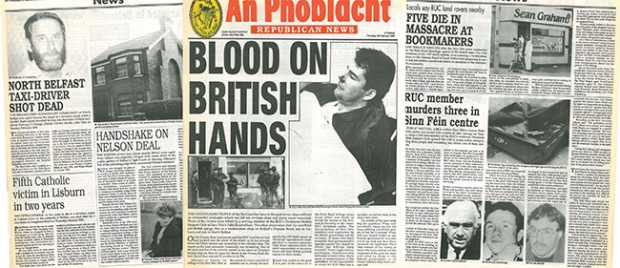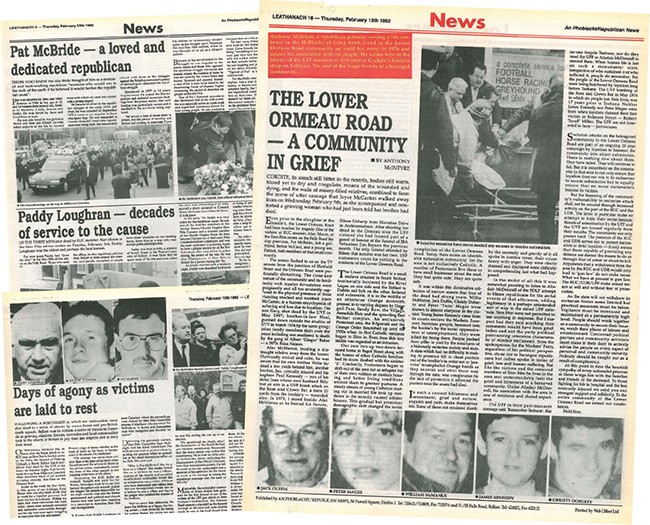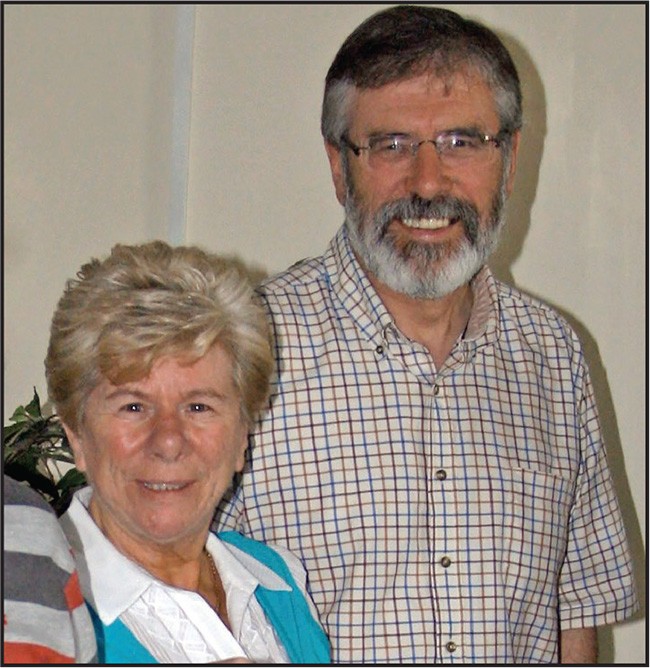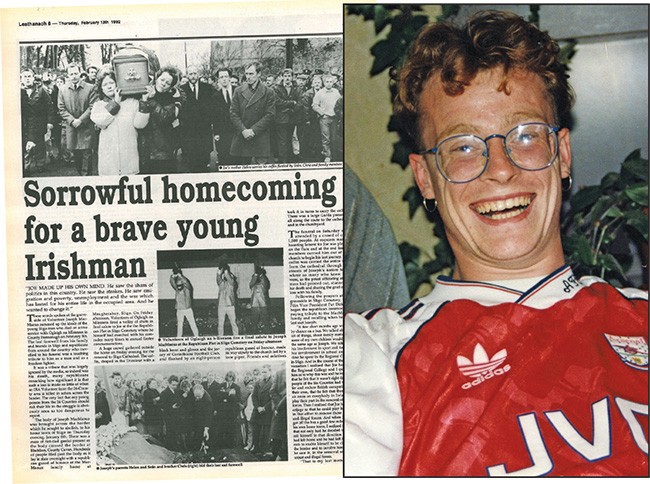13 February 2017 Edition
February 1992 - A baptism of fire with 'An Phoblacht'

Two RUC police armoured Land Rovers had been sitting near the UDA gang’s getaway car minutes before the attack
WITH the 25th anniversaries of two of the most notorious incidents of the conflict falling in the first two weeks of February, PEADAR WHELAN looks back on his first week as an An Phoblacht/Republican News photo-journalist. It was a week that left nine nationalists dead in separate gun attacks across Belfast while, on the Fermanagh border, a young IRA Volunteer from Sligo, Joseph MacManus (22), died on active service, shot dead by a member of the British Army.
In the first of two deadly assaults, on Tuesday 4 February 1992, Royal Ulster Constabulary police officer Allan Moore shot dead three men and wounded two others in Sinn Féin’s Belfast headquarters at Sevastopol Street.
The following day, Wednesday 5 February, a unionist gun gang from the Ulster Defence Association rampaged through Seán Graham’s bookmakers’ shop on the Ormeau Road in south Belfast, killing five customers and wounding nine other people.
For Peadar Whelan, those two days were a baptism of fire like no other as he had just embarked on the second phase of his pre-release scheme from the H-Blocks of Long Kesh, where he had spent 16 years, four of them spent on the Blanket and No Wash protests.
Prisoners serving life sentences in the Six Counties went through a pre-release scheme before they were freed on licence. Peadar was in a community project in Turf Lodge where a number of republican women looked out for them, especially Rita McCracken and her friend Patricia. Rita’s son, Volunteer Kevin McCracken, shot dead by the British Army in 1988, was in the H-Blocks with Peadar. (Rita sadly died in August 2016.)
As a native of Derry, which escaped the worst excesses of pro-British terror gangs, that first week with “the paper” brought into sharp focus the reality of brutal, bigoted sectarianism on one level and the degree of political abandonment experienced by Northern nationalists as the political establishments, North and South, turned the other way.]
MONDAY 3 FEBRUARY 1992 began with the news that the driver of a black taxi, Pádraig Ó Clérigh, had been shot dead in his north Belfast home by a UDA gun gang.
A member of the Falls Taxi Association, Pádraig was well known in Irish-language circles and was on the Conradh na Gaeilge Executive Committee. Just months before he was gunned down he spoke on RTÉ’s Cúrsaí programme about the sectarian attacks on the Association’s drivers that left two of them dead – Thomas Hughes, gunned down in July 1991, and Hugh Magee, killed in a hail of bullets in October 1991 as he ferried passengers to Ardoyne.
With the news of Ó Clérigh’s death ringing in my ears, I made my way to the community hub where my “work outplacement” was based. The building, only 200 yards from the An Phoblacht ‘bunker’ which also housed the Party President’s Office meant I could skip out at break-time and touch base with the An Phoblacht/Republican News team.
The staff were going through a transition as Northern Editor Jake Mac Siacais (whom I knew from the H-Blocks) was moving on to be replaced by Mickey McMullan (himself not long released on licence from the H-Blocks).
It was due to my close friendship with Mickey and my work as a PRO in the H-Blocks (as well as a sometimes columnist for An Glór Gafa, a jail periodical magazine produced by republican POWs incarcerated in England, the North, the Free State and further afield) that ensured my political activism would centre on publicity and An Phoblacht/Republican News when I was released.
My first experience of the office was a daunting experience – ringing the bell on the outer security cage, being buzzed in to stand at the second grille below the security camera to be scrutinised by unseen eyes before someone would eventually appear at the door and ‘magic’ me in before slamming the door, firmly locking it shut.
People I had never met before (Terry, Kieran, Mickey and Kevin) but who would become close friends and comrades stared at me from the admin room, looking at a face that wore an expression akin to that of a rabbit caught in headlights.
Squeezing my way through to the claustrophobic “Editorial Department” I was again met with bemused stares.
Laura Friel, shoehorned into a cramped box space in front of what then passed for a top-of-the-range Apple Mac, greeted me, as did Jake and Mickey. Big Mick was to come on board later.
Both were busy discussing with Laura how the killing of Pádraig Ó Clérigh would be covered.
For my first foray into republican journalism on the outside I was allocated some short “In Brief” stories and packed off to write them up.

• 'An Phoblacht' reports on the aftermath
It was on Tuesday 4 February, though, that I came to realise with bitter experience just how central to the republican struggle An Phoblacht/Republican News was. The paper was single-handedly challenging the Establishment narrative of the Northern war and prising open the steel shutters of silence and censorship behind which the British war machine was skulking.
I made my way to the office at lunchtime as I was trying to establish a pattern whereby I would leave my workplace and tie in with Jake and Mickey and see what they needed me to do.
While there, the relaxed but business-like atmosphere changed with one phone call.
A gunman had entered the Sinn Féin offices at Sevastopol Street on the Falls Road and opened fire in the confines of the reception area. It was already clear that people were dead but who or how many was uncertain.
For me the next few minutes were a blur as Jake, with years of experience, organised the response and, before I knew it, a driver, journalist and photographer were dispatched to the scene.
As these were the days before mobile phones and instant communications, the next hours were a confusing maelstrom of rumour, speculation and some hard news. Eventually we were able to establish that a lone gunman, having gained access to the building, opened fire, killing three people and badly wounding two others.
Of the dead, two were Sinn Féin activists: Paddy Loughran and former ‘Blanketman’ Pat McBride. The third fatality was Michael O’Dwyer, a local man availing of the party’s renowned constituency service.
Those wounded included ex-H-Blocks POW Pat Wilson and Nora Larkin.
And it is in situations like this that heroes are found in the most unlikely of places.

• Marguerite Gallagher, who was in the Green Cross Art Shop, chased and tried to grab gunman
Marguerite Gallagher, a well-known stalwart at the Green Cross Art Shop (selling prisoner crafts, flags, posters, books, etc) next door, heard the shooting. Instinctively, and fearlessly, she followed the assailant to his car parked on Sevastopol Street and tried to grab the murderer before he sped away.
In the aftermath of the shooting, the RUC heavy gang Divisional Mobile Support Units (DMSU) deployed to the scene revealed their anti-republican bias when they abused and harassed party members concerned about the welfare of relatives and friends inside, lying dead or wounded.
Not surprisingly, the finger of blame was initially pointed at loyalist gun gangs but, as the day wore on, it was established that the killer, Allan Moore, was a serving member of the RUC – in fact the elite and notorious DMSU based in west Belfast and whose colleagues had been sent to investigate!
Within hours of the attack, and around the same time as RUC man Moore’s body was discovered on the shores of Lough Neagh, where he is said to have taken his own life, a caller to a Belfast newsroom was naming the killer as a member of the unionist paramilitary Ulster Defence Association.
The repercussions of the attack on the Sinn Féin party dominated discussions on the Wednesday when I again arrived at the office and the call linking Moore to the UDA was being intensely debated.
Shockingly, it would be the UDA that would dominate the discourse with its systematic slaughter in the Seán Graham Bookmakers’ shop on the Lower Ormeau Road in south Belfast.
Two gunmen entered the building and opened fire with a Czech-made VZ58 assault rifle and a 9mm pistol, killing five males, ranging from 15 to 66 years of age, and wounding almost everyone else in the building as they had no escape route.

• Óglach Joe MacManus was killed in action in County Fermanagh
Just as with the attack on Tuesday, people went into overdrive as they attempted to ascertain the details for the paper, which was then published weekly and went to the printer on a Thursday.
Frantic phone calls were made to local republicans. As the day wore on, more and more information came through and it was obvious that the print deadline would have to be delayed to allow the reporters to produce as full an account of the incident as possible.
Not surprisingly, collusion and the role of the RUC was raised as local people reported that the UDA killers casually walked across to University Avenue to their escape car which was waiting just yards from where two police armoured Land Rovers had been sitting until just minutes before the attack.
In their excellent publication, Seán Graham Bookmakers’ Atrocity, Relatives for Justice exposed the extent of the collusion between the RUC and the loyalists in this massacre, including how the pistol used was ‘stolen’ from an Ulster Defence Regiment British Army base by UDA killer Ken Barrett, who gave it to UDA quartermaster William Stobie – both men RUC informers. And both men were involved in the killing of human rights lawyer Pat Finucane.
Now, 25 years later, it is clear that An Phoblacht/Republican News was to the fore of challenging the British, the unionist and the Free State establishments’ narrative of the conflict in Ireland, ensuring that the republican analysis was heard.
I am proud to have played my part with ‘the paper’, back in the day and today.



